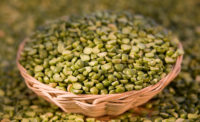Functional ingredients provide multiple benefits to snacks and baked goods
Ingredients like fats and oils, starches, dough conditioners and more form the backbone of snack and bakery formulations.

courtesy of Cargill

courtesy of Cargill

courtesy of QUALISOY

courtesy of Malaysian Palm Oil Council

courtesy of Cargill

courtesy of Cargill






Fats, oils, starches, fiber, dough conditioners and texturizers all serve critical functional roles in snacks and baked goods, particularly maintaining the quality of the product throughout the desired shelf life. As consumers demand cleaner labels, more health-and-wellness benefits and better sustainability, product developers face a wide range of functional ingredient challenges. Luckily, the latest generation of functional ingredients are more than up to the task, often serving multiple roles in the product matrix.
Advanced fats
With the industry directive to eliminate trans fat, there is a shift to oils that can serve as turnkey replacements to remove partially hydrogenated oils (PHOs). Frank Flider, consultant, QUALISOY, Chesterfield, MO, notes that high-oleic soybean oil and enzymatically interesterified (EIE) high-oleic soybean shortenings can work in wide range of applications. Soybean farmers have been ramping up production to increase availability and ensure a reliable supply. High-oleic soybean oils and shortenings are 100 percent U.S. grown and processed.
Flider notes that both products offer excellent shelf life and a neutral flavor profile, allowing the true flavors of the product to shine. “High-oleic soybean oil is a high-stability, zero-trans oil that is ideal for use in frying, baking and snack food production, providing increased shelf stability and a neutral flavor. EIE high-oleic soybean shortenings, which also contain 0 grams of trans fat, can be formulated to match virtually any PHO specification and are used for baking and deep-frying applications, particularly where the structure and texture provided by solid fats are required.” High-oleic soybean oil and EIE high-oleic soybean shortenings can be used for deep-frying applications for doughnuts and chips, and as an ingredient in cookies, cakes and icings.
QUALISOY has conducted extensive testing in conjunction with Stratas Foods, LLC, Memphis, TN, on the use of high-oleic soybean oil and EIE high-oleic soybean shortening in the production of fried snacks, doughnuts, cakes, cookies and icing. The data indicated these ingredients can be used as a replacement for virtually any partially hydrogenated oil, and—in many cases—can improve the quality, shelf life and stability of the product.
“High-oleic oil, and in particular high-oleic soybean oil, will be the ‘go-to’ for the snack and baking industries,” suggests Flider. “Being zero-trans, high in monounsaturates, and lower in saturates and polyunsaturates, this U.S.-grown oil provides the best intersection of health and functionality that we have ever experienced amongst fats and oils.”
The United Soybean Board, Chesterfield, MO, notes the following benefits:
- Extended shelf life—due to high-oleic soybean oil’s resistance to oxidation, it helps extend the shelf life of baked good without contributing trans fats or PHOs
- Cleaner label—high-oleic soybean oil eliminates the need for added antioxidants to help control oxidation, thereby providing a cleaner label
- PHO replacement—EIE shortening is an ideal replacement for PHOs in bakery products
In addition to the functional benefits, the United Soybean Board also cites several nutritional benefits. According to the results of its 24th annual “Consumer Attitudes about Soyfoods and Health” survey conducted in 2017, 60 percent of consumers view soybean oil as healthy, noting a reduced risk of heart disease as the most-recognized health benefit. The survey also notes that omega-3 fatty acids are recognized as the No. 1 healthiest fat, and soybean oil is a principal source of omega-3s in the U.S. diet thanks to the alpha-linolenic acid (ALA) present in soy.
“Our Pro-Formance high-oleic soybean oil extends the shelf life of baked goods and packaged snacks, allowing for the removal of TBHQ, which contributes to a cleaner label,” says Brain Anderson, vice president, innovation and marketing, Bunge, St. Louis. “It also offers a nutrition and traceability story. The oil delivers omega-3s, omega-6s and omega-9s, with only 12 percent saturates. It is sourced from 1,200 farmers we know in Indiana, Ohio and Michigan.”
Cargill, Minneapolis, recently introduced a low-saturated-fat, high-oleic canola oil under its Clear Valley brand. John Satumba, Ph.D., food ingredients and analytical chemistry director, global edible oils solutions R&D, notes that the oil is made from a canola hybrid that contains 4.5 percent or less saturated fat while maintaining high fry and shelf life performance, freshness and taste. “It reduces saturated fat content 35 percent from previous canola oil generations.” He notes that this oil is well suited to use in crackers that have seasoning coatings, as well as in a variety of different types of cookies.
As consumers are seeking out responsibly sourced ingredients certified, sustainable Malaysian palm oil addresses the environmental, social and economic aspects of palm oil production. Refined certified-sustainable Malaysian palm oil is trans-fat-free, non-GMO and odor-free, and it has a golden-yellow color. It’s a highly valuable ingredient in most bakery products, including crackers, pastries, biscuits, bread and cookies.
“Due to its excellent stability, the liquid fraction of palm oil, palm olein, is the world’s top choice as a frying oil for french fries, doughnuts and snacks,” says Kalyana Sundram, Ph.D., CEO, Malaysian Palm Oil Council, Washington, D.C. “Palm oil has a naturally semi-solid characteristic at room temperature with a melting point between 33° to 39°C. It does not require hydrogenation for use as a food. It has the functional properties of a trans fat (creamy texture, extended shelf life). Palm stearin is a very useful source of fully natural hard fat component for products such as shortening, and pastry and bakery margarines.”
Starch and fiber solutions
With consumer desire for clean label, Cargill notes a shift from modified starch to native starches in several product categories. As a result, the company’s food scientists are exploring new starch solutions and evaluating new combinations of native starches.
“We have studied the properties of dozens of native starches, including corn, wheat, potato and tapioca, and have found that, via custom blending and careful formulations, these basic starches can successfully fulfill many product requirements, including thickening, texturizing, stabilizing, moisture retention, gelling, film forming, dusting and dough binding,” says Michelle Kozora, technical service manager, Cargill. “For example, we’ve replaced the modified food starch in frozen cakes with a native starch. When thawed, these cakes maintain a smooth surface, fine crumb and ideal moisture level, plus they have a more consumer-friendly label.”
Kozora suggests Actistar, a resistant starch product, for use in gluten-free bakery formulations. This starch can be used to replace flour in gluten-free products, and can also provide increased fiber content for baked goods.
Bunge’s Honestly Corn functional flours are available through its Whole Harvest line of ingredients. These functional flours can serve as a replacement for modified starches, gums and alginates, but with a cleaner label, notes Anderson, with the label declaration reading “corn flour.” They are available in conventional, non-GMO, organic and whole-grain varieties.
Citri-Fi from Fiberstar is a natural citrus fiber. It’s non-GMO, gluten-free and plant-based. The company partners with citrus juicing companies in Florida, Mexico and South America and utilizes their leftover citrus pulp and peel to create the highly functional fiber ingredients, which find use in various baked goods and snacks, notes Jennifer Stephens, vice president of marketing.
Citri-Fi citrus fiber holds 7 to 10 times its weight in water and can emulsify 8 to 10 times its weight in oil. “The native composition of the fiber—soluble and insoluble fiber, and protein—plus the process gives it strong water-holding and emulsifying properties,” notes Nesha Zalesny, technical sales manager, Fiberstar.
Due to its water-holding properties, Citri-Fi is useful in a wide variety of snack and bakery applications. “This property enables bakers to maintain that moist, fresh-baked texture throughout the shelf life of breads, cakes, brownies and soft cookies,” says Zalesny. “This natural fiber can be especially useful in gluten-free food products, such as breads, muffins and cookies, as many of the ingredients used to replace wheat flour do not hold onto water tightly, especially over time. As a result, many gluten-free bakery products are sold in the freezer case to maximize the shelf life when going through the supply chain. The emulsion properties help formulators make the most of the fat they have in the system and can help them extend its functionality by emulsifying that fat with extra water.”
Stephens notes that Citri-Fi can also be used as a partial egg replacement and to reduce oil in bakery products. “Citri-Fi can reduce up to 25 percent of egg in baked goods while maintaining the texture and quality over shelf life.”
Nutrition matters
Some snack and bakery ingredients provide multifunctional benefits that extend into nutritional concerns.
Zalesny notes that while Citri-Fi has multiple valuable functional benefits, it’s a fiber ingredient, with nutritional merits. “Because it is the whole fiber of the fruit, it is still recognized as a fiber by the FDA. It can be labeled as a ‘citrus fiber,’ ‘dried citrus pulp’ or ‘citrus flour,’ which resonate well in the clean-label market.”
Stephens notes that Citri-Fi can also help product developers reduce fat levels in products. “Due to Citri-Fi’s high water-holding capacity, this fiber can replace from 25 to 50 percent of oil, depending on the bakery application, while maintaining superior moisture retention and quality over shelf life. Oil-reduced bakery goods typically are less moist and lack the full-fat mouthfeel. Citri-Fi’s ability to bind water and remaining oil tightly maintains the quality eating experience.”
Salt levels are also a nutritional target these days, and when a sodium substitute can provide fortification, the ingredient’s appeal grows. Cargill recently launched Potassium Pro, a new potassium chloride, a granular, food-grade, odorless, white crystalline salt with a typical saline-like taste. Mike Beaverson, senior marketing manager, Cargill Salt, explains that the product was developed to meet the needs of food manufacturers for potassium enrichment and for the replacement of sodium chloride. The product is well suited to use in both snack and bakery applications.
The timing of the ingredient launch coincides with the new labeling guidelines being implemented by the FDA. The new guidelines will require potassium levels to be listed on the Nutrition Facts panel, in addition to setting benchmarks to identify products that contribute a “good source” or an “excellent source” of potassium.
Improving stability
Delavau Food Partners, Philadelphia, has expanded its line of Encore ingredients, which offer shelf-life extension with mold inhibition. These clean-label solutions also help deliver a consistently high-quality eating experience.
Jeff Billig, vice president and general manager, Delavau Food Partners, highlights the different products in the Encore line:
- Encore Soft—anti-staling ingredients for a better eating experience
- Encore Fresh—antimicrobial solutions for shelf-life extension
- Encore Plus—dough-conditioning capabilities for formula optimization
- Encore Strong—ingredients for dough strength, volume, elasticity and tolerance
- Encore Relax—extensibility solutions for consistent pan fill and dough length
“Our Encore ingredients can be tailored to deliver benefits for an incredible range of snack and bakery applications, from rolls and pan breads to pizza, tortillas, doughnuts and sweet goods,” says Billig. “One of our most-recent innovations creates crispness in microwavable applications, like pizza, eliminating the need for a susceptor board. By eliminating the susceptor board, our technology results in cost savings, better alignment with a clean-label position and operational efficiencies, while still delivering a quality eating experience.”
Functional ingredients play a vital role in snack and bakery product development. In many ways, they are the backbone of the industry—particularly when they can provide multiple functional benefits.
Looking for a reprint of this article?
From high-res PDFs to custom plaques, order your copy today!













